Hi there folks. It's a fresh year and it has been a while since I felt compelled enough to put together another gigantic issue of
Matte Shot, but here we are at last. It's always difficult to get into the swing of these things during hot summer days (and nights), what with numerous home projects needing to be tackled during the good weather, baring in mind of course that summer here at the bottom of the world is a December to March kind of deal.
For the first blog post of 2022, I'm delighted to present - after a long wait - the first in a multi-part assessment and tribute to the wonderful world of Industrial Light & Magic matte painting. I've gone through as many ILM films as possible and assembled a vast catalogue of matte shots dating from the very formation of the company in 1976, through to the very last of the traditional, hand painted matte work, which as best as I can determine, was around 1994, from whence the customary tools of the skilled and highly trained matte exponent - brushes, pigments, glass and wedge tests - all 'went west', the traditional equipment and tools were thrown away as it were, and the demon computer, sadly, took over.
I was always a big fan of ILM from it's incarnation, and eagerly awaited new releases, often only to be thrilled by their skilled craftsmanship
(with the actual film in question sometimes being unworthy). I loved the period through the 1980's in particular, where ILM mastered miniatures, mattes and
especially optical cel-animated gags, which were a particular area of fascination for me until the digital era took all of that creative 'hand made' thrill factor out of it. What follows is a breakdown of, hopefully, almost all - or at least a great many - of ILM's hand painted matte shots from those glory days of an amazingly creative and highly skilled group of artists, cameramen and technicians. The films are all covered in chronological order, though the mattes within some of the big shows may be a little out-of-order due to the difficulties of collating and organising such mammoth illustrated posts. I'm sure you'll understand.
Oh, and please make the effort to view this post on a proper sized screen rather than some idiotic, gimmicky i-phoney toy. Many of the pics are high def, from BluRay and in some cases 4K frames where possible! The thought of somebody just 'flicking' or scrolling through these collections with their finger on a cell phone screen can be very disheartening. There is some great material to be had here.
Before embarking upon this exciting journey I should make mention of a new (printed) publication which has been sent to me. Italian digital matte painter and title designer Lorenzo Moneta - a long time dedicated follower of this very blog - has recently published a detailed handbook on the digital matte techniques, Creare Scenografie Digitali, from Dino Audino Publishing, though it's in Italian only.
--------------------------------------------------------------------------------------------------------------------------
***Final word: We here at Matte Shot wish to take this opportunity to extend our kind thoughts and utmost support to the people and legitimate government of the democratic nation of Ukraine.
All the best.
Pete
-------------------------------------------------------------------------------------------------------------------------
***This post, and all 174 previous blogposts known as 'Matte Shot', were originally created by Peter Cook for nzpetesmatteshot, with all content, layout and text originally published at http://nzpetesmatteshot.blogspot.com/----------------------------------------------------------------------------------------------------------------------
Here is where it all began ... in a manky old warehouse ... in a low-rent industrial zone ... in a galaxy not too far away....
 |
| I well recall seeing this masterpiece some 6 times during it's first run, including it's opening day around Christmas here in New Zealand at the long gone mighty Cinerama theatre in Auckland, on that massive screen in 70mm and 6-track stereo! Wow, what an event that blew my mind. Interesting sidenote was that I - and a handful of school friends - had already been introduced to STAR WARS several months earlier by way of an imported Super 8mm 400' digest edition, which were the film buff's only way to 'collect' movies back in the day, so we already had a preview of 17 thrill packed minutes of the George Lucas space opera. Man, did that Super 8 see some projection mileage, in fact I still have my EMPIRE STRIKES BACK 8mm print. |
 |
| Probably the most well publicised photo ever of a matte painter and his work, was this Starlog cover picture of a young P.S (Harrison) Ellenshaw posing with his famous power trench matte. |
 |
| Fascinating fact: P.S Ellenshaw (Peter Samuel) shown here at work, was, sometime after the release of STAR WARS, having lunch at Disney studios in the commissary with his famous father, the legendary Peter Ellenshaw, during preparatory work for Disney's THE BLACK HOLE. A producer stopped by the table and congratulated Ellenshaw senior on 'his' matte work in STAR WARS, to which the elder statesman matte exponent smiled and thanked the producer very much for the kind compliment - all while the younger Ellenshaw looked on in stunned disbelief! It was right at that moment that Ellenshaw jnr told his dad: "Right...that does it...I'm changing my name!", and Harrison Ellenshaw was 'born'. |
 |
| At the time, ILM didn't have a fully functioning matte department in 1976, nor among the hundred or so cameramen, model makers, animators and technical staff, a matte painter. Producer Gary Kurtz had put out feelers to Disney some months previous, to try and come to some arrangement for their matte department to supply the painted mattes. Harrison was hired as a sole sub-contractor under the newly devised company banner of Master Film Effects, purely for STAR WARS, specifically as a moonlighter - with full Disney approval. |
 |
| STAR WARS wouldn't be half the success it turned out to be without the invaluable creative input of conceptual designer and assistant matte painter Ralph McQuarrie. The whole 'look' and feel of Lucas' universe was largely down to Ralph, whose incredible conceptual paintings served the basis of all that was to follow. I still own the original folio collections of McQuarrie's concept paintings from the first 3 films which were sold at the time of each film's release. Here we can see Ralph blocking in a Death Star interior matte. |
 |
| McQuarrie was a highly skilled technical artist and commercial draftsman, with STAR WARS being his first cinematic project. In conversations I've had with Harrison, he told me: "Ralph was a genius, a great artist, a kind man, and he became a good friend. There would be no multi-billion dollar STAR WARS franchise without Ralph." |
 |
| The final composite. |
 |
| Ralph McQuarrie's true calling was in the astronomical art, with various planets and galactic views being his airbrush work. |
 |
| McQuarrie planetary matte art with miniature Dykstraflex motion control ships. Man, did this shot go over a treat on the huge 70mm screen in 1977 - complete with Ben Burtt's ear splitting sound effects coming at us from all directions. Oscar winner for both visual and audio effects, deservedly. |
 |
| More McQuarrie planetary artwork. Some of this matte art would be recycled, reframed, re-orientated for subsequent shots. Contrary to what many might imagine, STAR WARS was not a huge budgeted film, even for 1977, and deadlines loomed. |
 |
| McQuarrie artwork and motion control escape pod, which if I'm correct, was the first completed vfx shot to roll off the optical printer, after many months of delays and threats to shut the whole ILM shop down by the 'suits' at Fox, which was largely seen as some hippie hangout filled with layabouts. |
 |
| A great pic of Harrison, taken a couple of years ago at Lucasfilm, examining one of his original acrylic painted glass mattes, as part of the extensive, carefully curated collection of ILM matte art. |
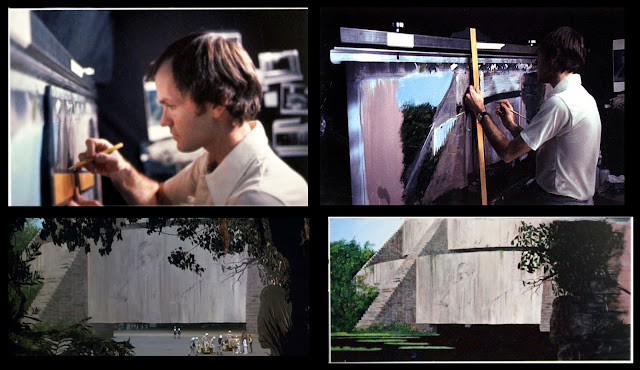 |
| Above matte art in progress at Disney. Sadly, George Lucas took it upon himself in recent years to substantially re-jig the original 3 films and in doing so, either dropped or altered digitally a number of the wonderful original mattes and opticals - such as this one (replacement shot not shown). Incidentally, the latter day alterations to SW often included idiotic additions and stupid background sight gags, to no good result. |
 |
| Discovering the city of Mos Eisley. Ellenshaw utilised a large photo blow up of Death Valley and hand painted the distant city onto it. |
 |
| The giant sandcrawler was just a partial facade for most shots (and miniature occasionally), though this long shot was a very small Ellenshaw matte painting. |
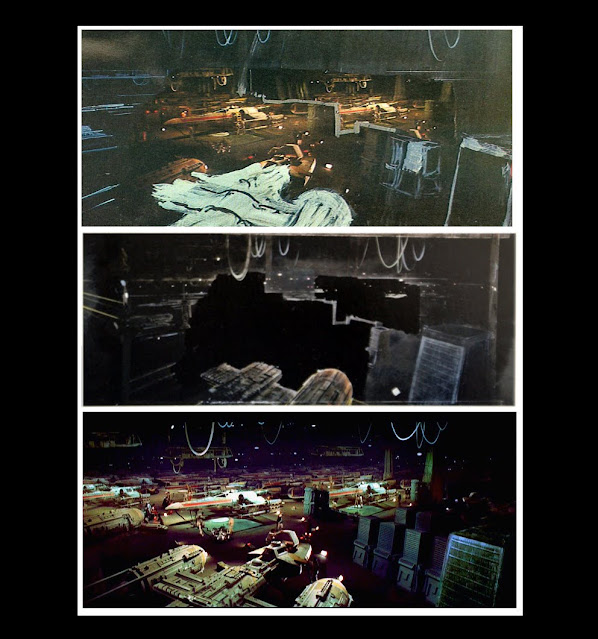 |
| The rebel hanger, with rough initial block-in at top; Harrison's matte art and the final shot. For the composite, Harrison used the same live action plate twice - once in the foreground and then again reduced in size in the background. The numerous mattes would take anything from 4 to 6 weeks each to complete - often with more than one being worked on at a time. The film had around 13 paintings, used in 17 different shots, though some were repair patches, to remove unwanted areas of the frame and paint over. |
 |
| The mighty Millenium Falcon and docking bay on the evil Darth Putin's Death Star. The mattes done at Disney were all made using their tried and true rear projection composite method, using separations. The shots composited at ILM were done with an entirely different method, that being bi-pack photography. Ellenshaw told me that the Disney method was far more flexible and allowed more freedom in assembling plates with the artwork. None of the mattes were done as original negative. |
 |
| Not sure about this one. Harrison said he didn't recall who painted it. It may have been Ralph or possibly art director Joe Johnston? According to Ellenshaw, the matte room at ILM - which itself was nothing more than a drafty, converted warehouse in the San Fernando Valley - was a less than ideal set up. "The second floor was not the ideal place to have a compositing camera. The camera would vibrate whenever somebody walked up the stairs. Not a good thing. We had signs all over the place about how to walk softly, but like any sign, after a few days, nobody takes notice of them". |
 |
| Harrison was paid the princely sum of US$1050 per week to create the mattes. From that he paid old time Disney matte cinematographer Bill Kilduff around $100 for each shot he worked on. Around half the shots were made at Disney, with the remainder done at ILM. Harrison and Kilduff would work nights at ILM on the matte composites. |
 |
| Dennis Muren - a legend in vfx now - was 'second cameraman-photographic effects' on STAR WARS under 'first cameraman' Richard Edlund and overall director of vfx, John Dykstra. Here, Dennis takes a light reading from one of Ralph's amazing matte paintings of the ominous Death Star. |
 |
| Ralph's expertly painted Death Star. |
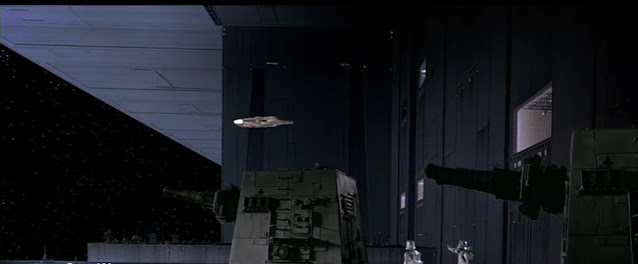 |
| Matte art Death Star with miniature foreground and blue screened stormtroopers and ship. **I should mention that, back in the day, while at high school, I persuaded our 5th Form english teacher (the late Mr Hassan) that as we were studying the 'social ramifications and sub-liminal message of cinema on the population' (or some such utter bollocks) that we, as a class, should go and see STAR WARS. And.... we did, as a whole class one night. I was never more 'popular' with fellow pupils (and even the bullies) for a week or so than I was then. |
 |
| Occupational Health & Safety is sadly lacking on the Death Star! A bit silly! |
 |
| 'Who was c*** who built this, I ask you?' |
 |
| The Elstree set in England of the throne room, and accompanying Ellenshaw matte art. |
 |
| A better view of what I feel was the best matte in the whole film, which apparently was very enthusiastically recieved by the director and others. This particular painting had to re-painted some three times before both Ellenshaw and Lucas were happy with it. All of the Disney mattes were composited with an ancient Bell & Howell stop-motion camera, built around 1912. According to Ellenshaw it was quite simple, yet extremely reliable, with rock steady movements along with the one-second turnover between exposures. |
 |
| The final shot, and end of the film. This almost got a standing ovation in the cinema, what with John Williams' unforgettable Souza-esque march score contributing so much to the scene. Bravo! |
--------------------------------------------------------------------------------------------------------------------------
 |
| With the vast and deserving critical and box office success worldwide of STAR WARS, Lucas naturally had to follow it up, though this sequel wasn't a patch on the original, it did have first class vfx work throughout, especially the stop motion sequences by Phil Tippett (sadly, not covered here...) |
 |
| ILM had now moved to an entirely new premises up in Northern California, with the old LA site becoming Apogee, with former ILM chief John Dykstra in charge. Shown above the the make up of the new ILM matte department, headed again by Harrison Ellenshaw (front). From left is matte artist Michael Angelo Pangrazio; matte camera assistant Craig Barron; matte painter Ralph McQuarrie; and matte cinematographer Neil Krepela. |
 |
| 'Matte artists in their natural habitat' (imagine that phrase as spoken by naturalist Sir David Attenborough if you will). |
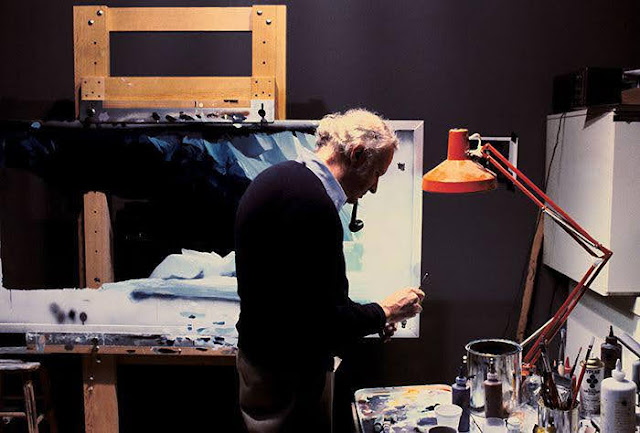 |
| Ralph with his trusty airbrush works on one of the numerous ice cave shots that open the film. |
 |
| Finished painting prior to composite stage. |
 |
| Above matte art as seen in the final film. |
 |
| A second view further back as all hell breaks loose. |
 |
| One of several subtle 'blink and you'd miss it' mattes, with Harrison Ellenshaw's painted power generator visible at left. Similar shots also used artwork such as this. |
 |
| Michael Pangrazio's painted snowscape. Mike had previosly worked on some low budget flicks and did a spell with Introvision before being hired by Richard Edlund at ILM. Mike would very quickly prove himself to be one of the most talented artists in the field, with scores of incredible and memorable shots over the next 15 years before transitioning to the digital medium, and much later over to production design. Last I heard, Mike was here in NZ working with Peter Jackson at our WETA Digital on various films like KING KONG, AVATAR and others. |
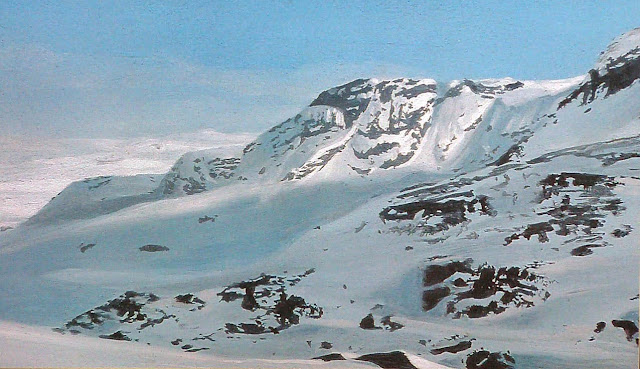 |
| Detail from above |
 |
| Mike would split his time on EMPIRE painting mattes and scenic backings such as this, for use with the jaw dropping miniature stop motion sequences. |
 |
| On the Taun-Taun set, with effects director of photography Dennis Muren; stop motion animator Phil Tippett; and matte artist/scenic painter Mike Pangrazio. The set up appears to be a multi-plane gag, with painted backing, stop motion mid section and separate, highly detailed glass painted foreground plane, just as the great Willis O'Brien would have done it. |
 |
| Top left: Ralph McQuarrie. Top right: Craig Barron. Bottom left: Mike Pangrazio. |
 |
| One of Ralph's elaborate cloud city paintings with the Millenium Falcon on the landing pad. |
 |
| The final composite. I spoke with Harrison Ellenshaw about Ralph and his heavy reliance on airbrush techniques which to me tended to have a little too much of a slickness and artificially smooth quality about it: "Ralph used airbrush a lot and it helped to create the 'look' of STAR WARS, and the overall success of the franchise. A good blend is a good blend. Personally, I never had much patience with airbrush... damn things clog and splatter... I don't like them." |
 |
| Matte cameraman Neil Krepela makes final adjustments to the reflex front projection rig initiated as a valuable means to composite live action plates with matte art, ILM's first use of this method, which I understand Harrison had picked up the idea from his former Disney mentor, Alan Maley, who used it successfully on the Bond picture, THE SPY WHO LOVED ME (possibly the best 007 flick of 'em all, though, I digress...). |
 |
| Another view of Neil with the front projection unit. |
 |
| Harrison at work on one of the many mattes required on EMPIRE. Around 70 mattes, or partial mattes were rendered in all by the three artists. |
 |
| Matte art of a different view of the same swamp. Incidentally, at risk of serious SW fan backlash, I hated that absurd 'Fozzy-Bear of the wetlands', Yoda, with a passion. I even think I laughed out loud when that creature appeared. It was cringeworthy then and remains so today 40 years later, especially as the popular Muppet tv show was still on the air and the moment this Yoda puppet opened it's mouth all possible attempts at credibility went out the window! Now there's an entire character that Lucas could have digitally rotoscoped out of the picture and replaced quite happily with something (anything!) more credible. God almighty, even the insufferable Jar-Jar Binks was a step above the muppet with the Miss Piggy / Fozzy Bear voice - and that is really saying something! There.... got that out of my system! |
 |
| The finished shot, though oddly optically flopped for some reason. |
 |
| Another view, this time painted by Ralph McQuarrie. |
 |
| Another McQuarrie painting on the matte stand. |
 |
| More splendid Ralph McQuarrie matte art. |
 |
| Close up detail. |
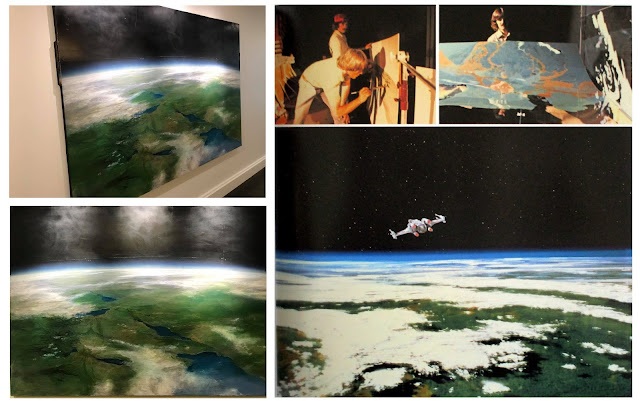 |
| I'm not entirely certain if the matte art at left is the same as the finals at right, but it looks close enough. Matte painted aerial view of Dagobah, rendered by effects art director Joe Johnston (top middle), with a separate plexiglass layer of painted clouds by matte artist Michael Pangrazio. |
 |
| To aid in the architectural aspects of some of the cloud city mattes, artist Mike Pangrazio enlisted help from ILM's miniatures shop to construct a variety of structures which would then be carefully lit and photographed as high resolution stills. These stills would be cut out, arranged and directly mounted upon the glass. Pangrazio would then paint additional features and extend the matte as desired (see below). |
 |
| The finished multi-plane matte art with pasted on photographic elements and artwork. The background sky is on a separate glass. |
 |
| Close up detail where photographic elements and brush work merge. |
 |
| Dual plane matte art on stand for final photography. I think that might be matte assistant cameraman Robert Elswit there - now an ace Academy Award winning production cinematographer, shooting all of Paul Thomas Anderson's pictures, including my number one fave BOOGIE NIGHTS. |
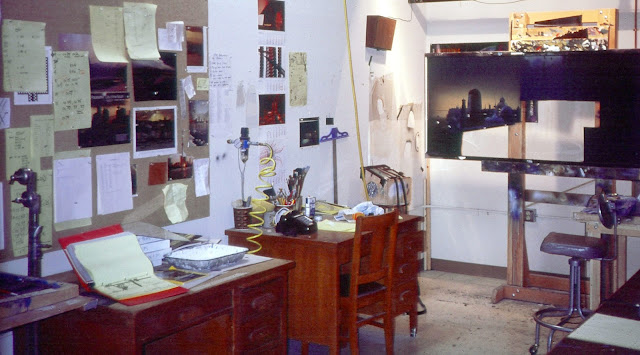 |
| Harrison's desk with partially completed matte art at right. "Richard Edlund, along with Brian Johnson were the special effects supervisors on ESB, and I will always appreciate that Richard and Brian left me alone in the matte department to do my job without interference. They were very supportive. willing to help out in any way." |
 |
| Striking matte art by both Pangrazio (foreground clouds) and McQuarrie (city). |
 |
| Two McQuarrie variations of Cloud city at different times of day. |
 |
| Decades later, the original glass paintings were brought out of storage at Lucasfilm for Harrison Ellenshaw to have a veritable 'blast from the past'. |
 |
| Top: Neil Krepela arranges miniature components in front of a substantial Mike Pangrazio matte painting (below) of the Death Star. |
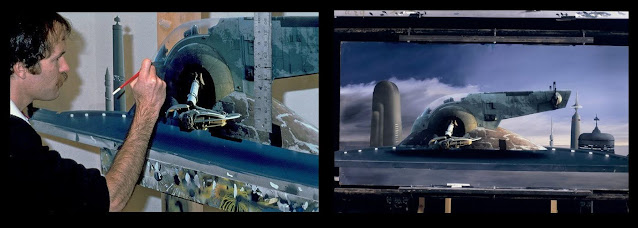 |
| Ellenshaw at work on the Slave 1 spaceship. The ship was to some extent a pasted on photograph, as were some of the background structures. |
 |
| Closer view with painting and photo blended in. |
 |
| As it appears in the final scene. |
 |
| A different vantage point of Cloud city, as rendered by Ralph McQuarrie. |
 |
| Ralph with his Cloud city painting on glass. Behind that is a separate painted sunset skyscape that was done by Pangrazio. |
 |
| Another highly detailed interior matte by Ralph McQuarrie that will serve as a nice 'in joke' when finalised. See below... |
 |
| Final shot with not one but three matte painters all shamelessly chewing the scenery in their collective 'big moment' on screen! Subsequent acting assignments were, regrettably, NOT forthcoming! |
 |
| Thespians at large.... "Stella .... Stelllllllaaaaaa...." |
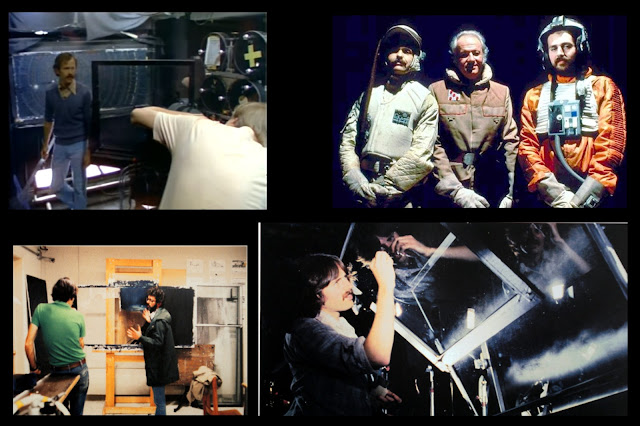 |
| Clockwise from top left: Ellenshaw & Krepela prepare to shoot a finished painting; The 3 Amigo's - Ellenshaw, McQuarrie & Pangrazio; Pangrazio at work on a starfield; Lucas confers with Ellenshaw on the swamp matte progress. |
 |
| Before and after of Millenium Falcon on the pad. |
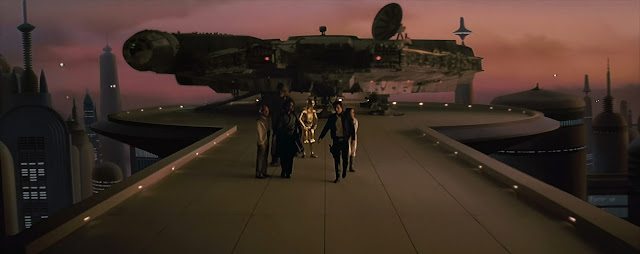 |
| As it looks in very high rez. |
 |
| Original Elstree limited set and Harrison's finished painting... |
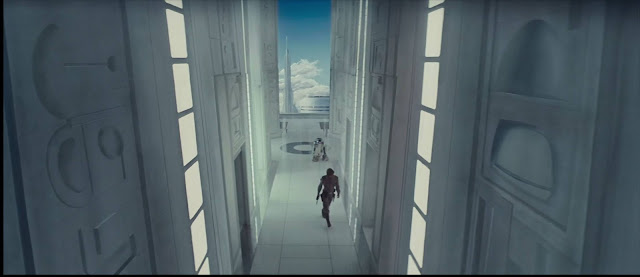 |
| Final composite. Ellenshaw stated to me that a great many wedge, or exposure tests would need to be made on every matte shot, and maybe a dozen takes before he got a satisfactory 'final'. |
 |
| McQuarrie's initial rough block in and the finished matte shot below... |
 |
| Chatting with Harrison is great. So many fascinating, funny and sometimes unpublishable anecdotes. He told me a nice one about beginning junior camera assistant, Craig Barron: "Craig was so enthusiastic. He absolutely loved movies. He would see every film that came out. He was still a teenager then, and would tell me that one day he would write the definite book on matte painting. I'd give him a hard time and tell him he would never get it done; too big a subject matter and all of that. I am thrilled that Craig proved me wrong, when 'The Invisible Art' was published. Craig is now a member of the Academy Board of Governors as well as an Oscar winner for effects on THE CURIOUS CASE OF BENJAMIN BUTTON in 2008. He owned and ran Matte World for 24 years. He's still an inspiration to the new kids who want to work in film." |
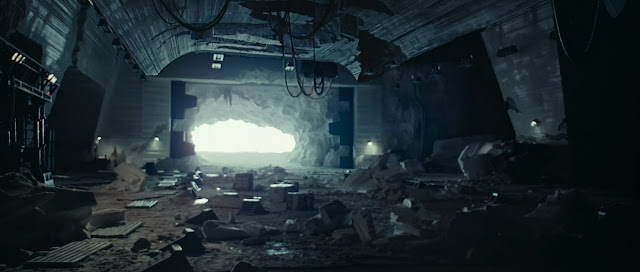 |
| A second view from a different angle. |
 |
| According to Ellenshaw, George Lucas would come by ILM before the screening of fx dailies and would stroll through the facility checking on progress. Getting immediate feedback on the matte paintings in progress proved invaluable to Ellenshaw. |
 |
| Ralph McQuarrie matte art for the climatic duel between good and evil. |
 |
| Final shot in 4K HD. |
 |
| Another vantage point of the same gantry light sabre swashbuckling effects sequence. |
 |
| Final shot. |
 |
| An atmospheric matte painted by Harrison Ellenshaw which will have a miniature of the Millenium Falcon blue screened into the landing pad. |
 |
| Here is another of Harrison's paintings, which when initially completed with laser strikes by the ILM optical department, caused a mild panic at a screening room viewing once it became quickly apparent that the optical boys had, in error - and no doubt under immense time pressure - composited all of the laser animation and explosions over the painting upside down back to front and coming out of the building!!! The footage was later recomposited correctly by the stressed optical department. |
 |
| Here is a most interesting matte painting by Ralph McQuarrie - the old fashioned set extension. Adding tops to studio sets was one of the most common uses of matte and glass shot work over a century. |
 |
| The superbly assembled finished shot looks a million dollars. |
 |
| A subsequent shot from the same sequence with painted set additions. |
 |
| Matte masters ply their trade. There was a real rush to complete all of the shots in time for the final locking of the negative for release printing. The matte crew worked double shifts in order to photograph and finish all of the shots. |
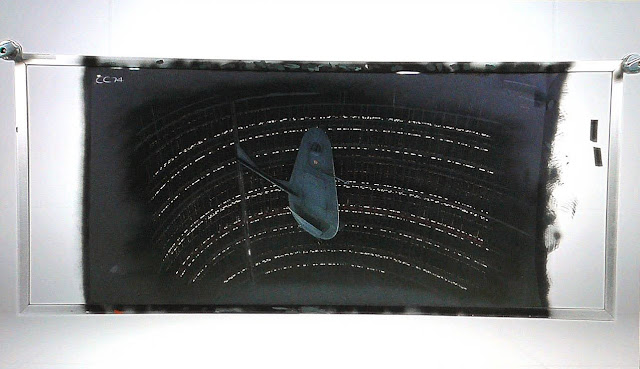 |
| I never quite figured out just what this thing is/was? |
 |
| Painted detail. |
 |
| On screen final shot. |
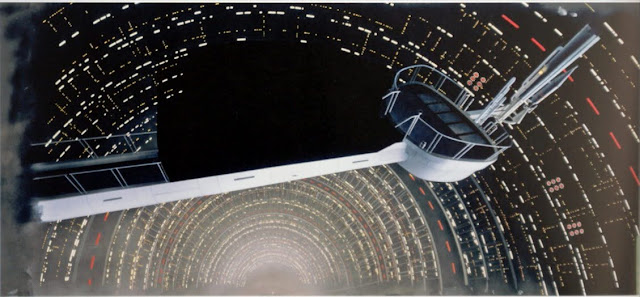 |
| More McQuarrie matte art. |
 |
| As it appeared on screen. |
 |
| Not sure here... might be a full set with backing or a blue screen shot? |
 |
| Matte art by Harrison with blue screened Luke. |
 |
| Harrison's meticulous, and surely headache inducing shaft painting. Must have driven the artist to near insanity drawing in all of these details. |
 |
| I think this was one of Harrison's pieces. |
------------------------------------------------------------------------------------------------------------------------
 |
| Sensational ad art here for a thrill-a-minute adventure yarn, very much of the old school, RAIDERS OF THE LOST ARK (1981) was a super hit, and wisely kept the visual effects in check, and strictly at the service of the story, unlike films of this new era which just don't know when to 'quit', to the point of 'enough already'. |
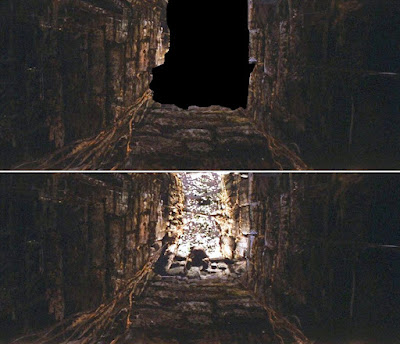 |
| The first matte shot comes in pretty much right after the main title card. |
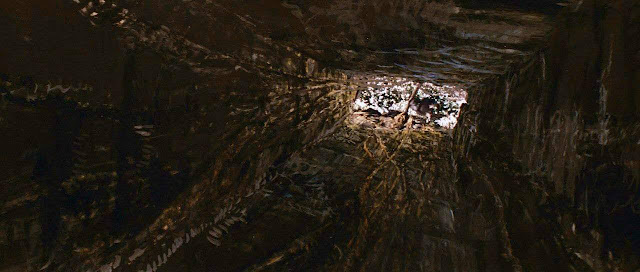 |
| Three undetectable painted mattes occur in a row, with views up a deep pit with just a small area of live action at the top. |
 |
| A second cut from the same set piece. |
 |
| The third matte in the sequence from a wide, ground level vantage point, with much here added by Alan Maley's brush. |
 |
| A gorgeous Nepalese landscape which was a full painting by Michael Pangrazio. |
 |
| Pangrazio at work, and the shot as it appears on screen, likely with added smoke animation gag and interactive light from the windows. The shot was very dark in the BluRay edition (as are so many on that medium), so I've lightened this frame somewhat. |
 |
| Early on in the show, a most intriguing effects shot occurs - that being the Pan Am Clipper. They found a genuine plane of the 30's vintage, though one landlocked only, so an additional plate was taken of a wooden pier and water elsewhere, with these elements combined with an extensive Alan Maley matte painting. |
 |
| Alan's matte painted dock and port, with even the airplane's Pan American logo branding painted into the matte. |
 |
| The finished shot. I assume some animation or interfearence gag may well have been implimented in order for the (real) propellor to crank up and spin over that area of the painting(?) |
 |
| An especially memorable effects set piece - following an edge of the seat full scale stunt sequence - was this bit where a jeep load of Nazi scum go over the cliff to their deaths. A very large matte painting measuring some 8 x 4 feet in size of the cliff face and valley floor below was created by supervising matte artist, Alan Maley. The painting was turned onto it's side for photography to allow a frame by frame tracking move with a similarly sideway mounted camera. Note the lower right picture of Maley pretending to paint a massive matte with an impossibly tiny brush. Alan had been in the matte business for decades, having begun back in the late 1950's in Wally Veevers' department at England's Shepperton Studios, painting on films such as DR STRANGELOVE and BECKET, as well as a stint at Pinewood with Cliff Culley where he painted with Peter Ellenshaw on Disney's IN SEARCH OF THE CASTAWAYS among others. Peter later found a position for Alan at Disney in the US where he would head the matte department and painted mattes on big effects films such as THE LOVE BUG, THE HAPPIEST MILLIONAIRE, BEDKNOBS AND BROOMSTICKS and the huge effects show ISLAND AT THE TOP OF THE WORLD. Later Maley would provide freelance matte and optical work on one of the best of the 007 Bond movies, THE SPY WHO LOVED ME. Alan sadly passed away at the young-ish age of 64, and was longtime friend and mentor to Harrison Ellenshaw. |
 |
| Individual frames from the sequence show the rear projected live action roadway plate as well as the ingenious stop motion animated falling jeep, complete with animated Nazi puppets falling out. |
 |
| Note the animated jeep and occupants falling to their death - all superb stop motion by Tom St.Amand, against blue screen.. |
 |
| Of course, if you are viewing this on some laughable i-phoney type toy, you'll never appreciate, let alone even see the detail as mentioned. |
 |
| Four scenes with matte work used to expand studio sets, miniatures, cloud tank gags and suchlike. The island was a painting, as were the views of distant landscape surrounds. |
 |
| Large miniature German sub split screened with matte painted island. |
 |
| Not sure but looks like a matte painting, again split screened with ocean plate. |
 |
| Modest sized stage set with matte art all the way around. |
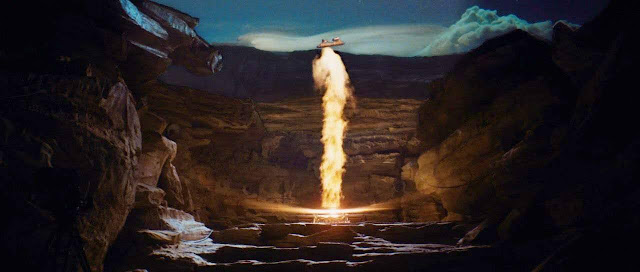 |
| Physical set, matte art, cel animation and cloud tank gag all at play. |
 |
| The final matte shot was, and remains, a true winner, and one of the most famous in the artform. Here, artist Mike Pangrazio is seen working on what will be the enormous and secretive government warehouse, where the so-called Ark of the Covenent will be stored away for later possible military use. |
 |
| First part of pullback to reveal vast storage facility. |
 |
| A frame from the final sequence, with a camera move, the shot stays on screen for around 30 seconds - an unusually long duration for any matte shot. Matte supervisor Alan Maley stated in 1981: "That shot was difficult from a matte painting point of view, because even though the painting is 6 feet long, when we start out on it we're actually focusing on a close area that's maybe 18 inches wide and about 6 inches high. Plus, when the camera is pulled all of the way back, the shot is still held on screen much longer than one usually likes on a matte painting. So, Mike had to paint to a much higher degree than on any of the other shots". |
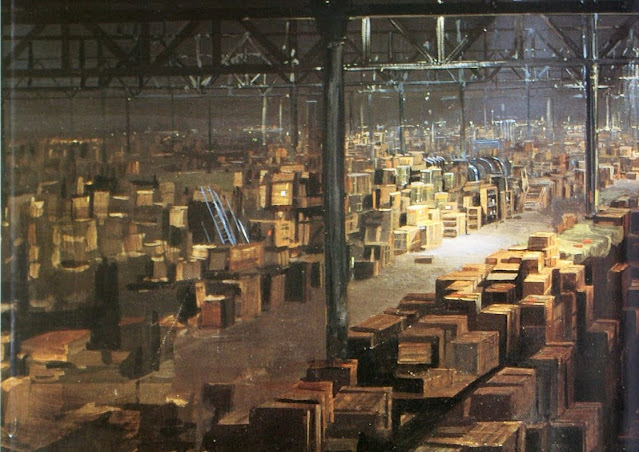 |
| Detail #1 |
 |
| Detail #2 I'm not certain, but I think Pangrazio may have organised a layout of small cardboard cartons to be still photographed in preparation for tackling this mammoth undertaking. I know that another later ILM matte artist, Mark Sullivan, did just that for a quite similar scene in the Coen's film THE HUDSUCKER PROXY. |
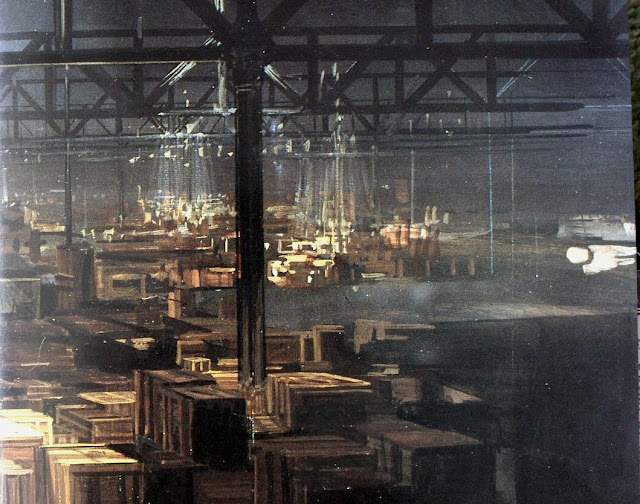 |
| Detail #3 |
-----------------------------------------------------------------------------------------------------------------------
 |
| The big budget fairy tale extravaganza, DRAGONSLAYER (1981) would be ILM's fourth production, and one that was loaded with a variety of visual and physical effects. The film itself was incredibly dull, though the amazing 'go-motion' animated/puppet work was a show stopper. |
 |
| Once again, Alan Maley was ILM's matte painting supervisor - even though he'd 'officially' retired from movies in the late 1970's. Here Alan poses for another candid 'joke' photo, using an impossibly tiny brush to lay in a vast landscape and castle. Years ago during the fx work on Disney's ISLAND AT THE TOP OF THE WORLD in 1974, the matte department was overloaded so they hired veteran Mathew Yuricich to help out. In my 2012 oral history interview with Matt he described the atmosphere in that department, which at first left him bewildered and a little concerned, at the constant side-swipes and banter going back and forth between Maley and Peter Ellenshaw. It wasn't until Matthew cottoned onto the very 'British' sense of humour, and natural use of irony and pointed,witty sarcasm (we here, as former Brit colonials in NZ definitely 'get it') - humour which to untrained American ears seemed like a constant barrage of insults, yet was quite the opposite. I can quite easily imagine it. |
 |
| Under Alan were two painters, the already experienced Mike Pangrazio (left), and the newly recruited Christopher Evans (right). Both paintings here feature in DRAGONSLAYER's opening sequences. |
 |
| A number of mattes feature in the film, usually night time mountains, rocky outcrops and the like. |
 |
| A beautiful full DRAGONSLAYER painting on display at LucasFilm, though possibly not used, as the matte below appears to be the final choice. |
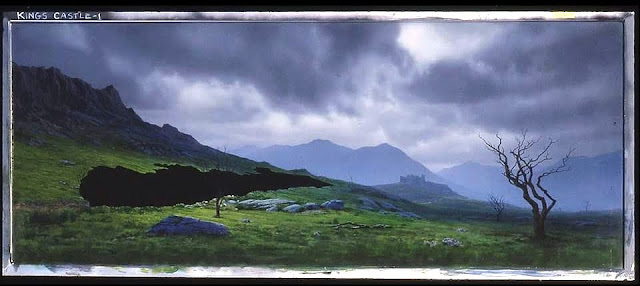 |
| Alan Maley designed this matte to be a front projection composite, though with painting and projected plate photographed in separate passes. Front projection permits a stronger, more evenly illuminated image of the plate, whereas rear projection can have issues with 'hot spot' and illumination 'fall off', which can be dead giveaways. |
 |
| Close up detail. |
 |
| The magnificent finished shot, composited with a camera pan to the right, as the horsemen ride to the castle. I think Chris Evans might have painted this? |
 |
| A series of four atmospheric mattes from DRAGONSLAYER. |
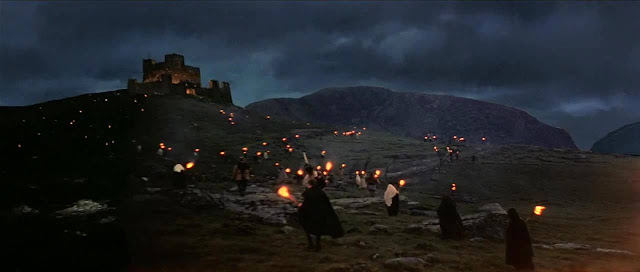 |
| They raid the castle at night. An Alan Maley matte shot. Maley stated: "I have a great theory about matte painting, that if you set it up like a matte shot, it'll look like a matte shot. But if you shoot it as you would a normal production shot, you tend to take the curse of it. The better the shots are, the less you're going to notice them, and I don't think you should notice matte shots in movies". |
 |
| Before and after from one of the numerous mountain mattes from the climax. |
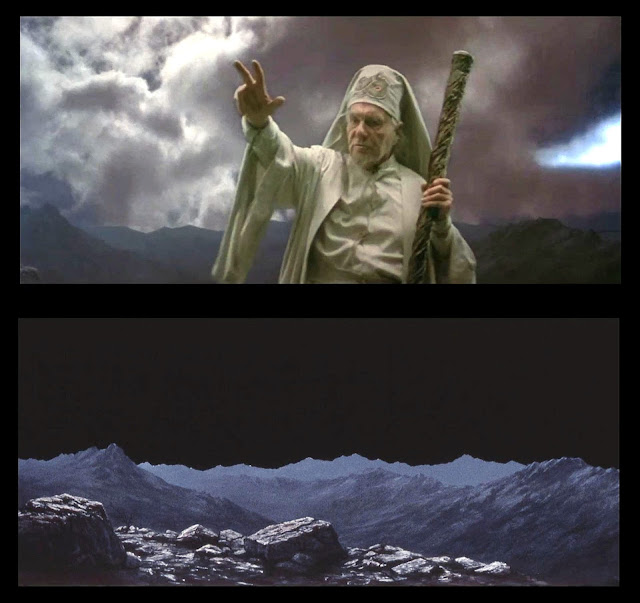 |
| Seems to have been mostly shot as virtual sets with bluescreen action and painted environs. |
 |
| More of the same... |
 |
| Ditto... |
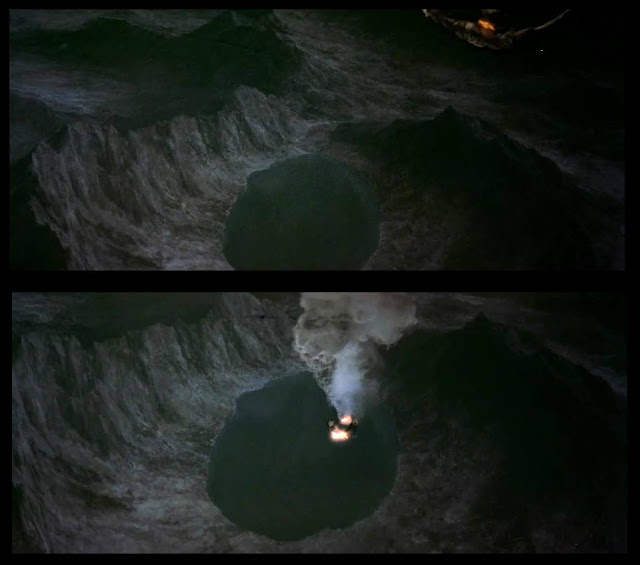 |
| Not sure whether this volcano crater and surrounding was a large miniature set or a substantial painted matte? Looks painted to moi. |
------------------------------------------------------------------------------------------------------------------------
 |
| I saw POLTERGEIST back in 1982 on a freakin' dynamite double bill with John Carpenter's THE THING at Aucklands magnificent old 1920 picture palace, The Civic. To say the two flicks blew my mind would be putting it politely! POLTERGEIST was a 100% bonanza of thrills, scares, ghosts, apparitions, obnoxious teen kids and corpses, with powerhouse ILM input in all avenues, from brilliantly orchestrated and assembled opticals, fabulous cel animated gags, creature fx, matte art and that's not even all when you appreciate the heavy duty mechanical and physical effects side! |
 |
| The show had a relatively light matte painting load, which given that ILM was tied up with so many ongoing projects that year, was probably why. Michael Pangrazio was matte artist and this was one of his invisible matte shots that most people never spotted. A great deal of the housing development in the valley as well as the distant hills and sky were matte art. |
 |
| Here's a real nifty effects shot that's worth talking about. The forboding bank of storm clouds closing in over the suburb and the Freeling house, which is really when all the shitstorm kicks off - in more ways than one. The shot is largely a cleverly rendered matte painting by Pangrazio of the neighbourhood, rooftops and sky. The main body of the encroaching storm cloud comprised of the standard practical injection of tempura white paint pigment into a clear water tank and manipulated by resident 'cloud wrangler' Gary Platek. In a darkened room, Platek used special probes to manipulate the tempura in the water until the correct 'formations' of pseudo-cloud were created, which were then photographed, numerous times until just the right effect was achieved. The tank elements were then composited into Pangrazio's painting, with Mike even blending aspects of the tank cloud footage with more subtle matte art, including a shadow moving across the distant hills. So while a great portion of the storm cloud was a physical effect created in a tank, specific areas of the same cloud bank were in fact 2-dimensional artwork, smoothing the edges out, but the whole thing ties together so beautifully, it made for a most memorable shot, and looked great in Scope up on the big theatre screen back in '82. Kudo's to matte cameraman Neil Krepela and optical man Dave Berry for pulling all of this together. |
 |
| The tornado strikes and causes havoc. The left side of the frame is an actual set, while the right side - including the dug out pool, kids swings, fence, houses and sky - is a complete matte painting. The young actress reached up too high and some roto was needed to have her arm clear Mike's matte art briefly. The actual tornado was a special physical effect created by Gary Platek in the water tank with tempura paint. |
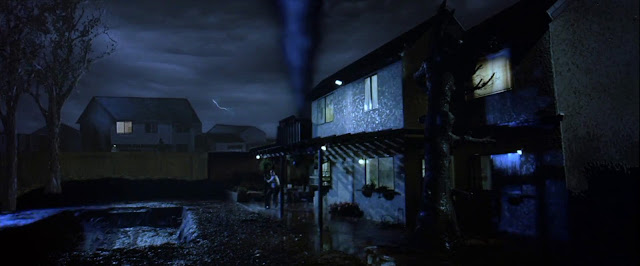 |
| A reverse angle, this time shot on a location elsewhere, but heavily augmented with Pangrazio's matte art comprising around 50% of the frame, including neighbouring homes, trees, backyard and sky. |
 |
| A key moment in POLTERGEIST where we learn just why the Freeling house has pissed off so many ghouls from the afterlife. This is a highly detailed Mike Pangrazio matte painting, which proved quite an ordeal as the artist was repeatedly asked to make changes and additions. Official screen credited director Tobe Hooper and other director Steven Spielberg (though never outright credited as such but we all know he helmed the picture from the sidelines) , made artistic directives at odds with each other and even with how Michael felt the shot should look to make it work best. Mike called the finished shot "Too busy". |
 |
| Final shot - here with the late, great character actor James Karen - with rear projected live action plate and subtle backlit 'scratched off' small bits of paint to give the illusion of grass moving in breeze, to match the live action. |
 |
| The film concludes (or does it?) with the Freeling house imploding and vanishing into the netherworld. Don't laugh... this happens more often than you might think! I know, because I read it on the world wide web(!!) |
 |
| Multiple element shot with live action street, miniature house that was literally blown to pieces with Richard Edlund's very own shotgun(!), optical gag sparkles, flashes and subtle matte painted neighbourhood. POLTERGEIST was up for the best FX Oscar that year, but lost out to another, utterly undeserving ILM film. More on that later... |
------------------------------------------------------------------------------------------------------------------------
 |
| I enjoyed the original TREK films, especially the first one from Robert Wise - which I feel was grossly neglected. Anyway, STAR TREK 2-THE WRATH OF KHAN (1982) was a solid show and very entertaining. Lots of effects but only a handful of matte shots. |
 |
| Two ILM artists shown here, with Christopher Evans at top left being in charge, while ILM newbie, the extraordinarily talented Frank Ordaz, shown at bottom right. |
 |
| The key matte shot was what they called the Genesis Cave - reportedly a shot that nobody in the matte department liked and felt uniformly that the composition was all wrong. |
 |
| Final composite. |
 |
| The same sequence features some three mattes, with this being a Frank Ordaz rendering. |
 |
| Some close up detail of Frank's work. Ordaz would become an exceptional and prolific painter at ILM for the next few years before quitting the film business to focus primarily on gallery art and illustration work. |
 |
| The last of the STAR TREK 2 mattes is this full painting which features in that same setting, and worked well. |
------------------------------------------------------------------------------------------------------------------------
 |
| At risk of a smack in the mouth, I'll be right up front and state I couldn't stand this movie, in truth, disliking it with a vengeance. E.T - THE EXTRA TERRESTRIAL (1982) was a trite, manufactured piece of shameless, sugary, cinematic commercialism, and worst of all, it stole the FX Oscar that year from BLADERUNNER - an infinitely more deserving recipient (and even POLTERGEIST as a close runner up was way up there!) But don't get me started on Oscar injustices... |
 |
| Among the matte shots were these two, with Michael Pangrazio as chief artist and Chris Evans and Frank Ordaz also on painting duties. Neil Krepela was matte cameraman, assisted by Craig Barron. I understand that Frank Ordaz was responsible for one or both of these mattes. |
 |
| The diminutive intergalactic irritant extra-terrestrial, discovers the bright lights of the big city. A tiny puppet creature, foreground miniatures and a large painted cityscape rendered on hardboard by Chris Evans, all shot in camera. Camera assistant Karl Herrmann drilled out dozens of tiny holes in the 8 x 4 foot painting and arranged a set up behind involving frosted acetate strips, small fans and lights - all shot at 36fps to create a twinkling effect. Nothing new there, as studios had been doing that for 50 years, particularly MGM's famous Newcombe department who absolutely mastered the art of backlit twinkling lights and neons etc on a hundred Technicolor musicals - incidentally one of my fave old time matte trick shot techniques that still to this day never fail to amaze me when watching old movies. |
 |
| The original masonite painting on the wall at George Lucas' film factory. The painting was able to be backlit with flickering light effects. |
 |
| E.T marked a major turning point for ILM - that being the introduction of their first original negative latent image matte composite. It seems hard to believe now, as premier matte artisans such as Albert Whitlock had mastered that method right down to a fine art, with optimal visual fidelity and quality for decades. Both Pangrazio and Evans stated that they were great admirers of Whitlock's work and learned a great deal from Al's methodology. |
 |
| Several shots in this backyard sequence utilised matte painted night skies, with the moon in various degrees of visibility under cloud for each cut. The skies were all painted, and at first tentative attempts were made to do the shots as latent image, with eventual highly successful results after numerous trials and tests. Of interest, the clouds themselves weren't painted, but were in fact pieces of cotton wool that camera assistant Barron had carefully cut out and shaped and then stuck onto a pane of glass. The pasted on cotton wool clouds would be repositioned for subsequent shots in the same extended night sequence to suggest the passage of time. ILM were very happy with the first generation quality of the o/neg method but felt constrained by the hard fact that one must be absolutely confident in composition, matte placement and all else when shooting such shots as the shot is npretty well 'locked in' once the plate is filmed. Old time practitioner Al Whitlock over at Universal on the other hand was so experienced in the o/neg method, that nothing was impossible, even the most complicated, mind-boggling latent image composites were able to be achieved, provided firm decisions and utmost control of all steps along the way were respected. ILM would use this o/neg method off and on for occasional films thereafter, especially for those intended as made for tv, and later on, key matte exponents from the company would use it extensively. |
 |
| The film comes to a conclusion - and about bloody time I say - with a horde of BMX bikesters in full flight (don't ask) headed into the setting sun(!) All matte painted here, in layers on individual glasses to allow depth, plus a sun element at back. The kids were a mix of actors on bluescreen stage and some puppeteered go-motion miniature work. It worked well. |
 |
| Craig Barron (left) and Neil Krepela (right) establish meter readings on the multi-plane glass shot set up. The shot comprises some 3 layers - the first with a treeline, the second with mountains and hills, while the third one at rear was the sun. |
 |
| Another deep plane matte multi-element shot, most likely utilising the puppet kids on miniature BMX's. |
 |
| Multi-part vfx shot. Miniature spaceship and forest surrounds, with the far treeline and distant city and sky painted. |
------------------------------------------------------------------------------------------------------------------------
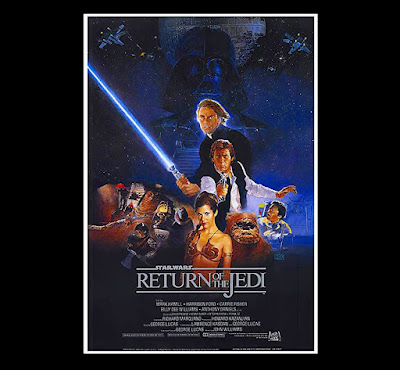 |
| Fans were waiting, and George delivered RETURN OF THE JEDI in 1983, and again while not as good as the first film, was an improvement over the second. An all out balls-to-the-wall visual effects showcase, loaded to the hilt with amazing and jaw dropping trick work throughout. |
 |
| A mammoth matte shot film, JEDI had a very busy troop of matte artists, headed by Michael Pangrazio. Shown above is painter Christopher Evans wearing his trademark brown dustcoat with one of his dramatic mattes on the stand. |
 |
| Michael Pangrazio confers with matte cinematographer Neil Krepela. |
 |
| ILM matte artists always seem to double as scenic painters as well. Top left is Ralph McQuarrie on EMPIRE but not involved with JEDI; right is Mike Pangrazio (also on EMPIRE), while bottom left is Frank Ordaz with his forest painted backing for a key JEDI action sequence. |
 |
| Frank Ordaz - one talented painter indeed and seemingly able to use his brush skills in matte work and it's own peculiar requirements with ease. |
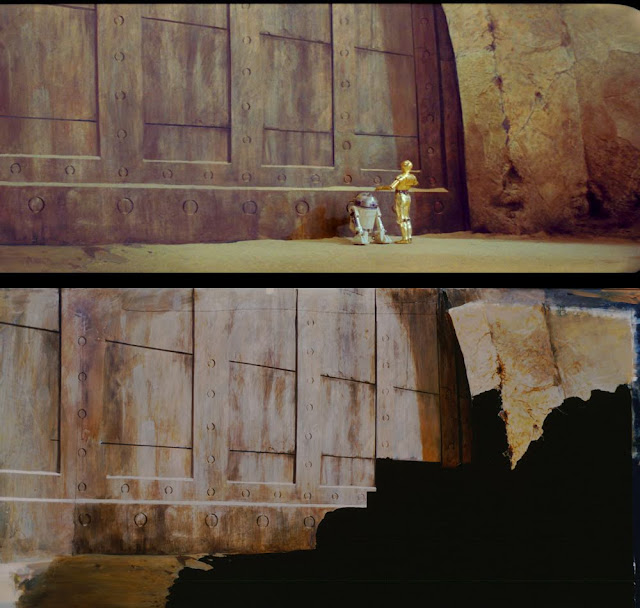 |
| An invisible before and after JEDI shot. |
 |
| Even in high def, the blending is excellent. |
 |
| An interesting matte that unfortunately never made the final cut. |
 |
| A Mike Pangrazio matte painted shot, assembled on ILM's AutoMatte system. |
 |
| Pangrazio matte art. |
 |
| Now, not all matte shots are grandiose show-stoppers. Often, they are utilised to hide, conceal or fix things that aren't meant to be in the shot. This is one such example by Frank Ordaz where he was tasked with painting in a little sliver of desert to mask out the mechanical rigging holding the craft in 'the air'. This sort of invisible trickery has forever fascinated NZ Pete. |
 |
| The final shot, though not so as you'd ever know. |
 |
| Chris Evans at work with jeweller's loop, painting in the most minute of detailing on the Death Star matte art. |
 |
| An overall view of same. |
 |
| An incredible Mike Pangrazio rendering of the Death Star docking bay interior. |
 |
| The finished scene. |
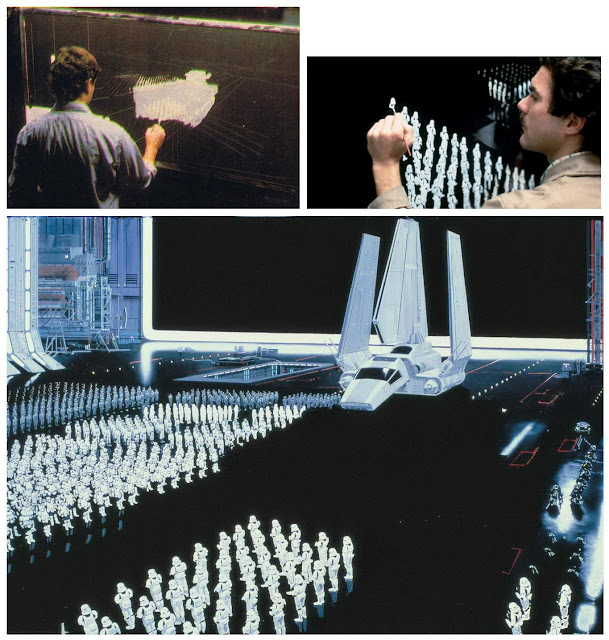 |
| Top left we see Mike at the initial stage where he is working out crucial perspective lines, while at right we see fellow painter Chris Evans helping out with the scores of painted stormtroopers. |
 |
| A later view of the same environs from another angle, as painted, with astonishing skill by Frank Ordaz this time. |
 |
| Here, Frank works on a highly detailed painting of the Millenium Falcon. |
 |
| This pic is a work in progress frame, where much is still to be done. I just love seeing partially complete or blocked in mattes in their early stages. |
 |
| Close up is a view to behold. |
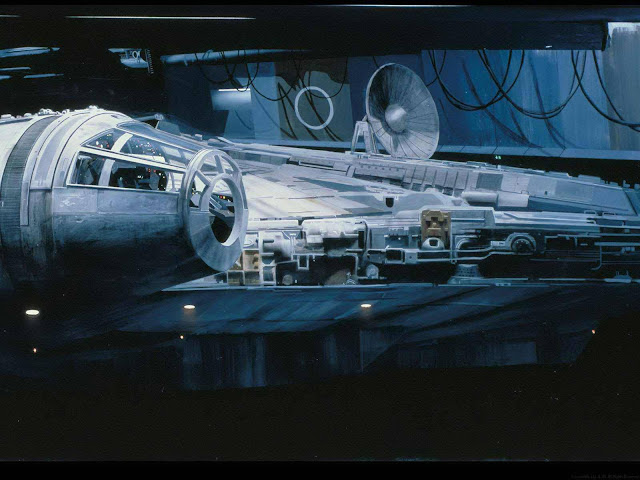 |
| Ordaz matte art detail. |
 |
| Breathtaking brushmanship. |
 |
| The finished scene once the two actors have been dropped in via travelling matte. |
 |
| A Mike Pangrazio rendering of the Death Star, complimented by foreground miniatures. |
 |
| Pangrazio applies final touches. |
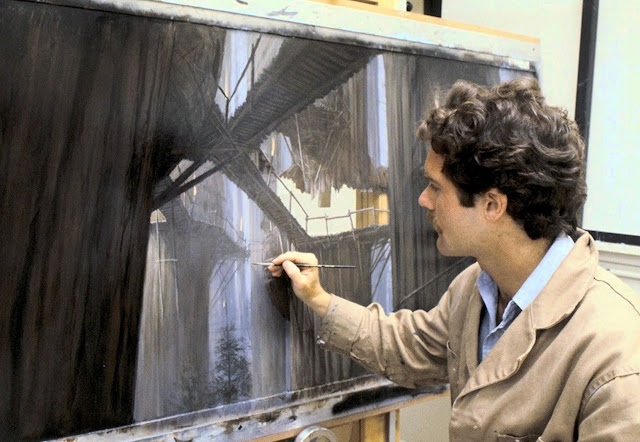 |
| Chris Evans works on the Ewok tree top village, where many mattes will be used. |
 |
| The final result of the above Evans painting. |
 |
| A very nice wide view of Ewok-Town. |
 |
| A rare sight indeed, of artist Chris Evans sans brown dustcoat, as he works on a beautiful matte. |
 |
| A wonderfully accomplished finished shot. |
 |
| This matte appeared, printed way down, in the EWOKS tv films, though it may also have appeared in RETURN OF THE JEDI. |
 |
| Steps needed to introduce live action characters into an expansive Frank Ordaz matte painting of the Ewok village at night. Areas of paint are carefully scraped away to permit rear projected live action plates to be added in separate passes. |
 |
| ILM's VistaVision rear projection unit for composite photography of matte art, as used for the Ewok shot above and below. |
 |
| A nice, crisp picture of Frank Ordaz's Ewok matte art prior to RP composites. |
 |
| Camera operator Craig Barron and matte artist Chris Evans. |
 |
| The final glorious result. |
 |
| George Lucas confers with vfx art director Joe Johnston on a major matte painted shot. |
 |
| Individual frames from the above illustrated matte composite set piece. |
 |
| The same setting as seen in daylight, with matte art by Christopher Evans. |
 |
| Original full painting, nicely framed and on a wall some place. |
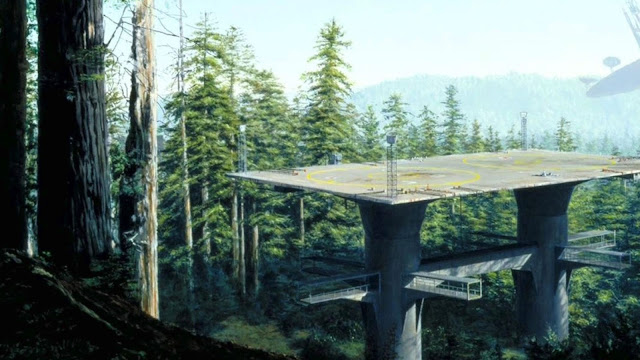 |
| Detail |
 |
| More detail from the same matte. |
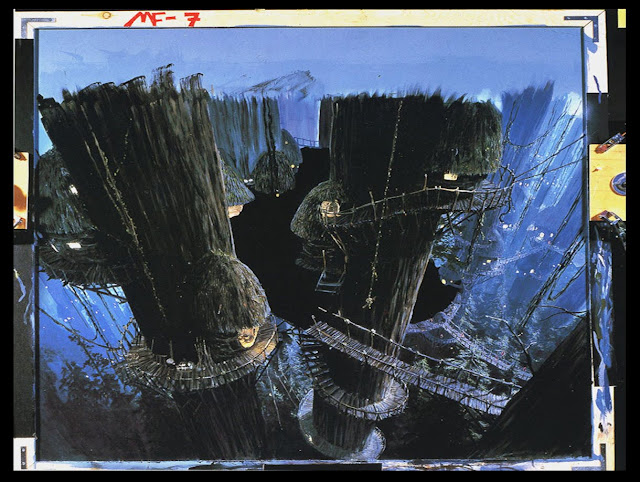 |
| This one is a Michael Pangrazio painting, and it's a beauty! |
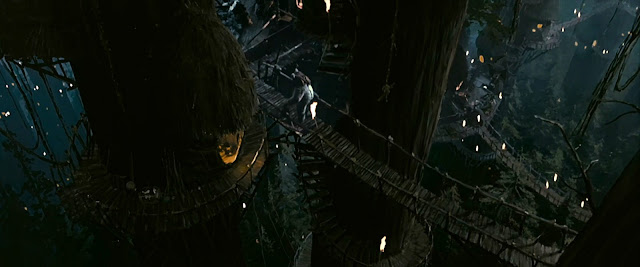 |
| The same painted matte when combined with live action. |
 |
| Pangrazio busy at work on a matte that I don't think ever made the final edit. |
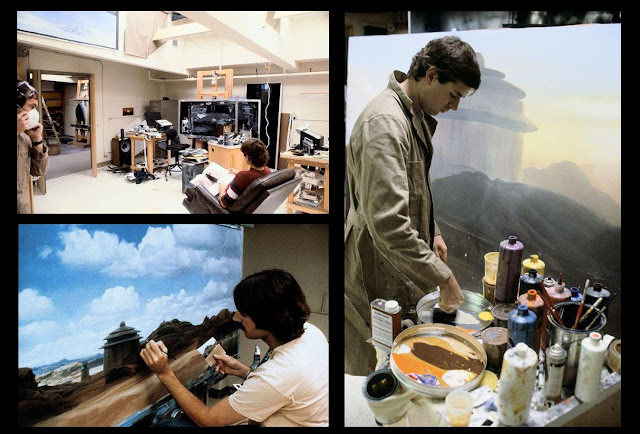 |
| Various examples of Pangrazio at work on JEDI. |
 |
| Another of Pangrazio's mattes that I don't think made the final release prints. |
 |
| Composite of shot not ultimately used. |
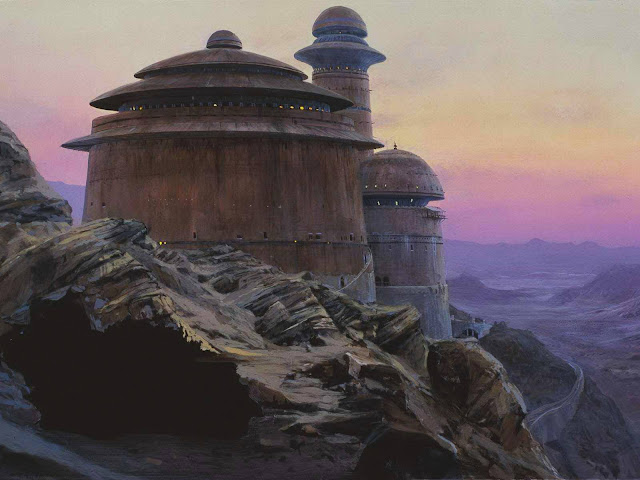 |
| Detail |
 |
| Closer detail... |
 |
| Even closer detail still... |
 |
| Frank Ordaz painted this spectacular craft. |
 |
| Close up detail... |
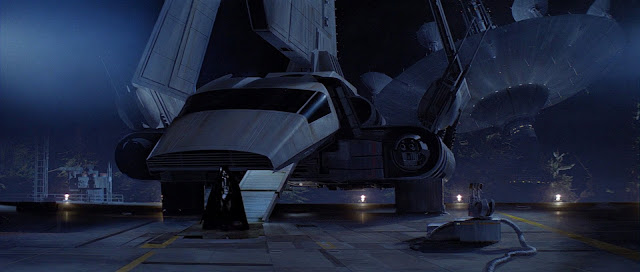 |
| The shot as it appears, with the evil, unhinged Darth Putin, oh, I mean Vader (or do I?) descending. |
 |
| A brilliant matte painting of Endor, rendered by Frank Ordaz. According to FX supervisor Richard Edlund, originally the film had only 15 mattes planned, but once the production saw the quality of the shots already done, which Edlund called "really fantastic stuff", they upped the ante and the number grew to around 50 shots. |
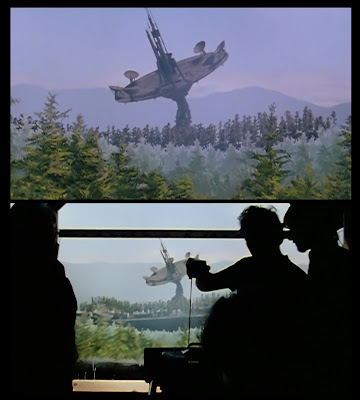 |
| The miniature set with radar dish also utilised a foreground glass painting of trees and foliage to lend depth to the set. |
 |
| The fx crew prepare pyrotechnics to blow up the dish. Note Chris Evans' glass painted foreground. |
 |
| Supposed to be JEDI shots but look more like mattes from the telemovie EWOK films to me. In fact it looks suspiciously like a Syd Dutton matte that was done for one of those EWOK shows? |
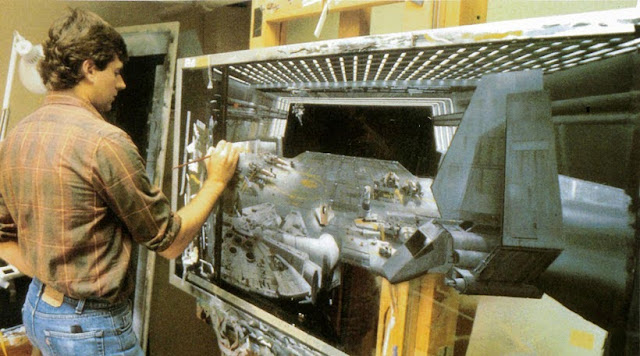 |
| Mike Pangrazio finishing off an awesome painting of the landing bay in the Death Star. |
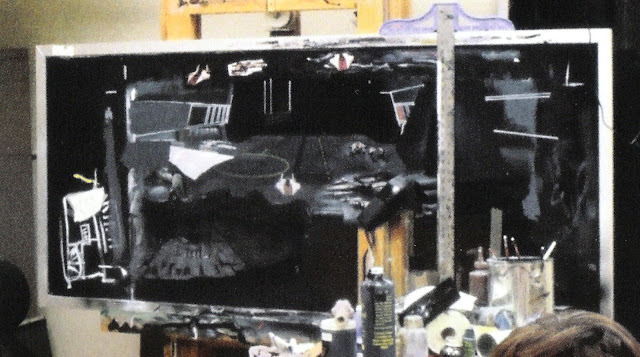 |
| Here is a most interesting pic, of the same Pangrazio matte in it's early, roughed in stages. |
 |
| Part of the final shot, which served as a slow tilt down, with several patches of live action going on. |
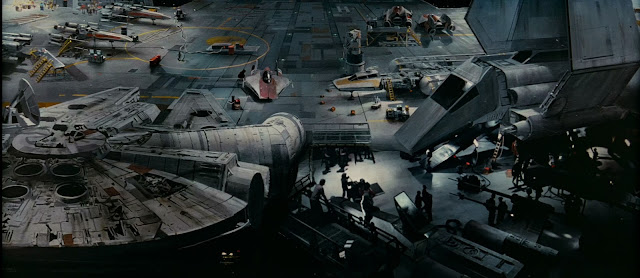 |
| The lower part of the same tilt down. Mike found it useful to draw the audience's eye to the live action by introducing subtle things like a large painted circle around the floor and pockets of spotlight illumination upon the extras - an old trick in matte magic going back decades, and notable in films like FORBIDDEN PLANET made in the mid 50's. |
 |
| A close look at Mike's superb work. Note the circle painted around where live action people will be layered in. |
 |
| Mike's workspace was like the H-Bomb had dropped... but the results speak for themselves. |
 |
| Intriguing pic here of the Death Star trench, painted by an artist named Richard van der Wendt (I think?) |
 |
| Now this shot was very neat, and one I'd never spotted until just recently. Chris Evans painted this forest setting for a very quick cut and a battle ensues. |
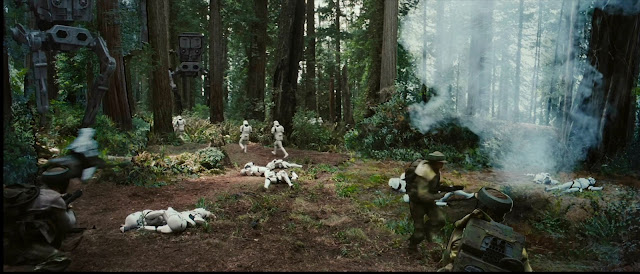 |
| The finished shot is all but invisible as a painted matte. Nicely animated imperial walkers coming through the trees. Terrific bit of work here all round! |
 |
| Chris Evans at work on some planetary art - possibly on an actual physical globe? Did I mention that JEDI took home the best vfx Oscar? I did?...well here it is again. |
---------------------------------------------------------------------------------------------------------------------------
 |
| Another winner in the best visual effects Oscar stakes, was INDIANA JONES AND THE TEMPLE OF DOOM (1984). The flick hit all the right buttons and was a rollicking, rollercoaster ride right from the opening lavish musical number, with the delightful Kate Capshaw hoofing and singing Anything Goes - in Mandarin no less (possibly my fave sequence, oddly!), right through to the eye-popping stop motion mine chase and it's subsequent cliffhanger dust-up. Sadly, the next two INDY films were less than impressive, and to my stunned amazement, I hear they're dragging poor ole' Harrison Ford out of his retirement village to star in yet another(!) Indiana Jones with hip replacements, a walking frame and all. |
 |
| Tons of top shelf visual effects throughout, and a fairly healthy chunk of matte art to boot. |
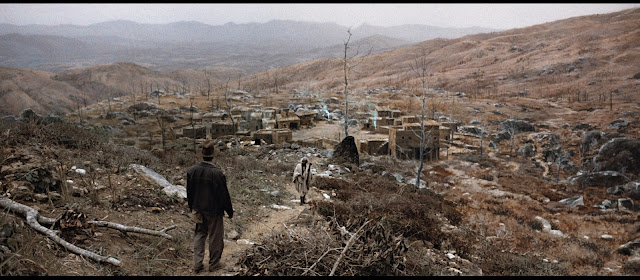 |
| Superbly blended matte art, painted by Chrsitopher Evans. |
 |
| Blue screen shot with actors dropped into extensive matte painted vista, with destroyed village. Fires and smoke doubled in as well. |
 |
| The palace where some strange stuff happens and the dinner menu is most definitely to be avoided at ALL costs! This full painting was rendered by both Pangrazio and Evans, though both were unhappy with the final result, and thus sought alternate means to present the same shot . |
 |
| Images taken of the detail work as painted onto the initial, albeit, unused Pangkot Palace matte. See below for how it was ultimately achieved... |
 |
| The eventual palace matte shot was done very differently, and with excellent results. For this incarnation which ultimately was used in the final cut, Pangrazio prepared a basic, simplified cut out onto a large 8 foot sheet of black foamcore - traced from a slide of the original unused painting - onto which were glued small bits of wire and other odds and ends to lend roof top details. Pangrazio and Barron would then transport this rudimentary cut-out onto a suitable exterior, chosen for the likelihood of a good sunset. The cut-out was nailed to some timber stakes which had been pounded into the earth, with a suitable sky in the background. An additional foreground glass was also set up, onto which the artist painted impressionistic details amounting to not much more than highlights here and there and some minor detailing. Pangrazio himself stated at the time: "The painting itself looked ridiculously bad - just brush strokes that end in a black sky, but on film, I think it's one of the best things I've done." The final shooting was a success, with a real and vibrant sunset behind the silhouette, and looked 100% real. |
 |
| A later matte painting as Indy and pals approach the palace. |
 |
| Michael Pangrazio at work on the palace, which was optically flopped in the final cut. |
 |
| High Def frame of the final shot. |
 |
| An insightful before and after from probably the best matte shot in the film, where the tiniest of live action plates of the kid were integrated into a magnificent Pangrazio matte painting. |
 |
| Mike's awe inspiring matte is a sight to behold. The shot was done as latent image, though unusually, the artwork was completed a long time before the live actio bit was shot. |
 |
| That same village, previously shown at the start as desolate and 'dead', was again seen in a more healthy state later in the film via matte magic. Doubles for the main characters - one of whom was matte painter Caroleen Green with a wig - walk down to the village, which didn't exists and was just a part of George Lucas' spread. Later on, Mike Pangrazio furnished the verdant valley and bustling village in paint. |
 |
| Final shot, with a gradual tilt upward. |
 |
| Some danger lurks in those caverns, where at left cameraman Craig Barron is setting up a forced perspective miniature against a Frank Ordaz matte painting. |
 |
| Completed shot with miniature foreground, matte art cave, steam optical overlay and actors dropped in via travelling matte. |
 |
| An invisible matte shot with the Pangkot Palace just visible far on the horizon. |
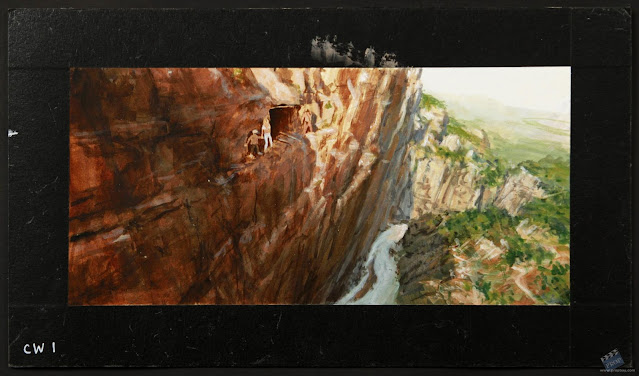 |
| Now the action packed climax was a doozy! Here is a piece of pre-vis concept art which aided in establishing the look for the many mattes required. |
 |
| The matte painters were often 'press-ganged' into performing duties outside the safety and warmth of the ILM matte room. Here we see artists Caroleen Green and Frank Ordaz atop ladders painting scenic backing for a key vfx shot which involved actors and miniature deluge. |
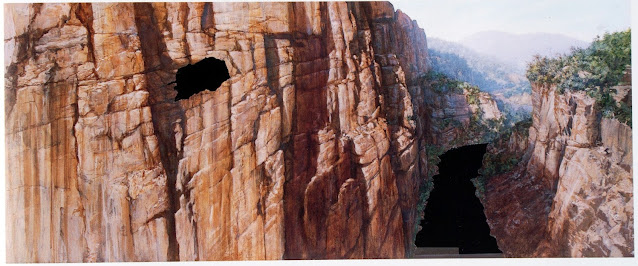 |
| Chris Evans' spectacular establishing shot of the cliffs and valley in Sri Lanka. |
 |
| The delightful Caroleen Green adds some final small touches to Chris Evans' painting. |
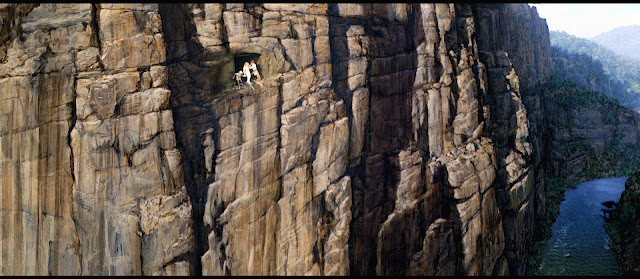 |
| The completed scene, with rear projected live action on cliff ledge as well as water in river. The now very famous director David Fincher was an ILM cameraman for a few years, and was responsible for adding an authentic, subtle aerial wobble to the shot, to give the realistic appearence of being taken from a chopper (ie: the flying thing, not the motorcycle!) |
 |
| The set piece is crammed with expert visual effects, stunts, sound fx editing and more! Here is one of several downviews which involved multi-element composite work. A practical set, shot in Britain, matte art extending the cliff further, an actual river filmed 2nd unit and a considerable amount of hand rotoscoped business as characters legs flop over the matte area and some poor bastards are flung to their demise in the crocodile infested river below! |
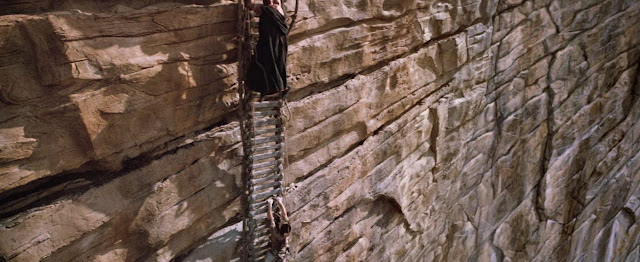 |
| Another view with matte painted right half of frame. |
 |
| Presumably all the ILM artists had a part to play in making all of these cliff face mattes. |
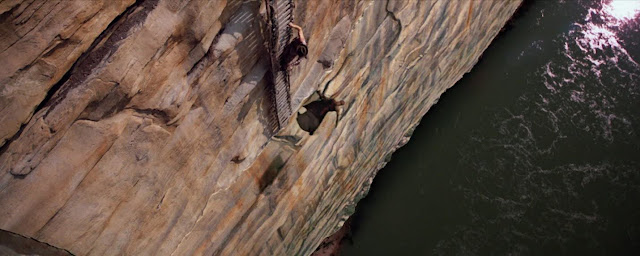 |
| Don't look down! |
 |
| I told you not to look down you fools! |
 |
| The steps involved in assembling the shot shown above. The UK live action stunt players and actor; river plate; hold out mattes; matte painted rockface; rotoscoped cel animation for falling stuntman; and finished test. |
 |
| Just to conclude, here's a close up of that aforementioned rejected painting of Pangkot Palace. |
--------------------------------------------------------------------------------------------------------------------------
 |
| Kirk, Spock and Bones are all back for more in STAR TREK III-THE SEARCH FOR SPOCK (1984). Again, a big ILM assignment with much model, optical and cel animated work, as well as some nice matte painted shots. |
 |
| At left, what appears to be an unfinished version of the planet surface sequence. |
 |
| The final shot with much painted set extension added. |
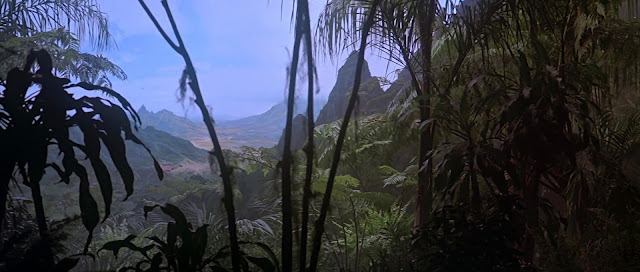 |
| A sprawling planetary vista was created by Chris Evans as an enormous backing cyclorama of some 25x16 feet in size, completed with foreground foliage and greenery as the camera does a wide pan around to the actors. |
 |
| Presumably painted matte art. |
 |
| Caroleen Green's beautiful other-worldly sunset is picturesque as the Enterprise in flames crashes to the surface. Great, subtle cel animated and roto gags for the flaming ship. |
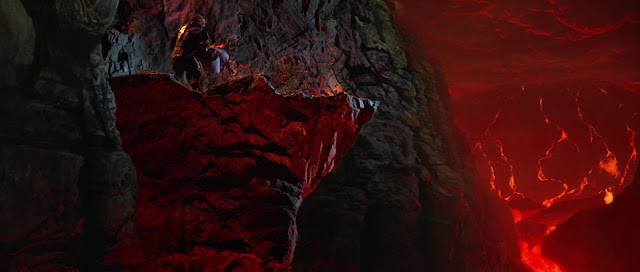 |
| Slugging it out as lava flows below. Not a good idea. |
 |
| Chris Evans' concept painting for the planet Vulcan. |
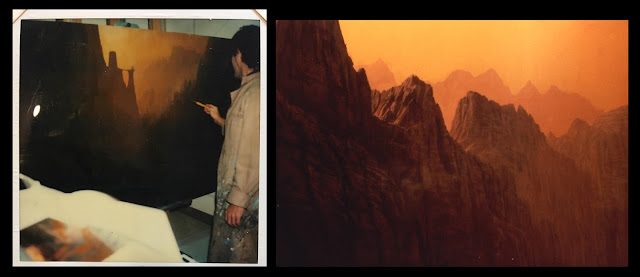 |
| Either Evans or Ordaz here at work on a Vulcan establishing shot. |
 |
| The completed shot. |
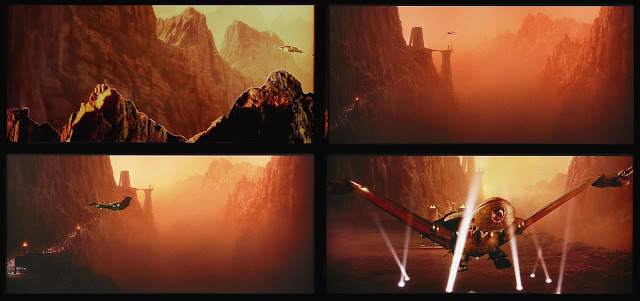 |
| More Vulcan mattes, with Green, Ordaz, Pangrazio and Evans all likely doing their bit. |
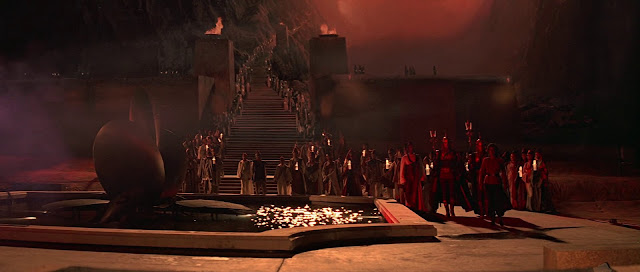 |
| Upper half of frame painted in later. |
 |
| The non-denominational Vulcan Temple, with Chris Evans at work. |
 |
| Flaming sunset over Vulcan. A rather striking, full matte painting. |
---------------------------------------------------------------------------------------------------------------------------
 |
| A massive hit, NEVER ENDING STORY (1984) was never a film that appealed to me, but seemingly, I was in a minority. Ace British effects man Brian Johnson - a two time Oscar winner - supervised all of the visual and miniature effects in Europe, where the film was shot, with ILM sub-contracted to provide several matte painted shots, though personally, I never felt the ILM shots were anywhere near their usual standard. Noteworthy, the most sucessful mattes in the film were not actually made by ILM at all, and were contracted over to veteran vfx man Jim Danforth to do. In the interests of completeness, I've included Jim's mattes here as well. |
 |
| I'm not sure but this was either a Caroleen Green or Mike Pangrazio painting, and I'm not certain if it appeared in the actual film? |
 |
| A simililar shot - one of several - though it always looked like a miniature, or at least a multi-plane kind of deal to me? |
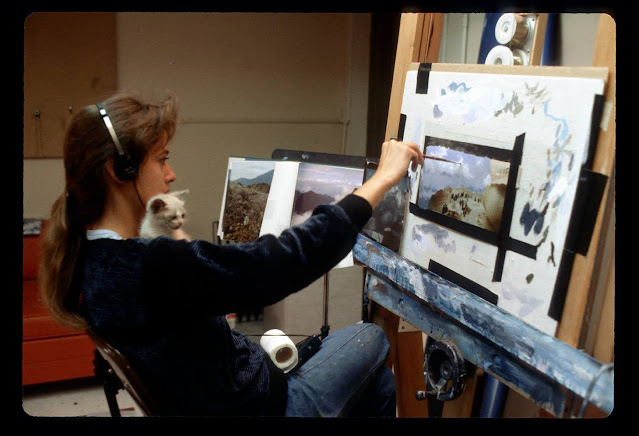 |
| ILM's Caroleen Green (and kitten) at work on a matte conceptual sketch. I get the impression that Caroleen is 'feline' realllll good about her career at ILM. |
 |
| Dramatic cloudscape on glass. |
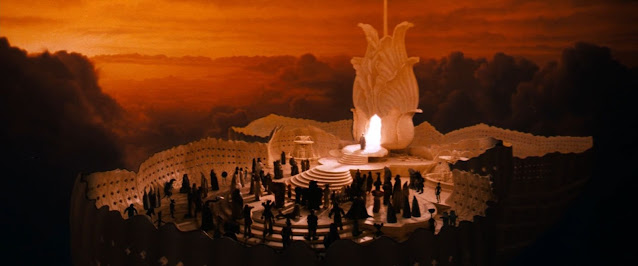 |
| Final shot. |
 |
| The ILM artists included Mike Pangrazio, Frank Ordaz, Caroleen Green & Chris Evans. |
 |
| Matte composite. There were two sequels, and I preferred part 2 actually. Al Whitlock supervised on that, with his long time associate, Syd Dutton rendering almost all of the many excellent mattes, though Leigh Took and Peter Talbot in the UK did some work as well. The 3rd film was forgettable, but had some nice shots by UK painter, Doug Ferris. |
 |
| ILM matte. |
 |
| A rare pic of one of the large glass paintings that ILM produced. |
 |
| Finished marry up of painted and live action. |
 |
| Closer look at the brush work. |
 |
| Matte art, apparently by Caroleen Green, with both frames likely early tests and versions of intended final shot. |
 |
| The same scene as it appears in the release version, with drifting clouds that looked like the real thing. |
 |
| Green with her work in progress. |
 |
| A second cut of the same sequence. |
NON-ILM NEVER ENDING STORY MATTES RENDERED BY JIM DANFORTH: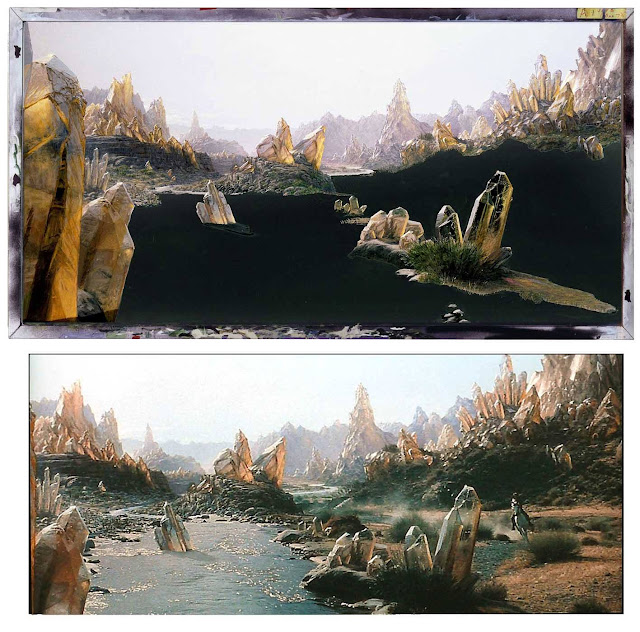 |
| I've always felt that the strongest asset in NES were the utterly magical mattes made by old time visual fx specialist and matte painter, Jim Danforth. This matte of the Crystal Valley remains my all time favourite among Jim's many painted mattes. Composited, as is Jim's usual preference, via rear process projection plates, the finished image simply glows with an almost tangable feeling of wonder that the film is purporting to present. |
 |
| Another of Jim's wonderful mattes - again, simply magical. |
 |
| I asked Jim and he was pretty certain these were his shots too. |
 |
| The final matte is also a Jim Danforth shot. |
 |
| Credit where credit's due. Note David Fincher's name in the credits. |
-------------------------------------------------------------------------------------------------------------------------
 |
| I have already done an extensive coverage on both of these made for tv films, and that substantial article can be found HERE. |
 |
| Both EWOK telemovies were absolutely loaded with great matte shots. A veritable feast for matte art surveyors of all ages, religions, ethnic background. View here. |
 |
| Pangrazio and one of the 60 or so EWOK mattes, almost all of which were assembled as original negative shots. |
 |
| Artist and matte camera crew make incredible things happen... |
 |
| One of Caroleen Green's marvellous EWOK ADVENTURE paintings. |
------------------------------------------------------------------------------------------------------------------------
 |
| An oddly melodramatic little love story from John Carpenter that had it's moments. A handful of below-the-radar effects shots from ILM, including some painted mattes by Frank Ordaz at the end. |
 |
| Watch the skies... |
 |
| I assume the sky was a painted view by Frank, with miniature spaceship and animated light effects. |
 |
| Really well done actually, with underside reflecting the desert floor and horizon on it's chrome dome. |
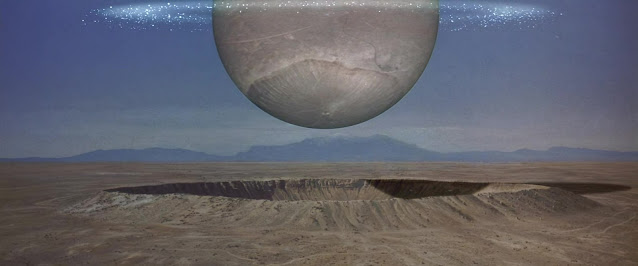 |
| Ordaz matte art, where it looks as if Frank painted in the reflected scenery, based upon the final behind the scenes photo. |
 |
| The quite striking imagery that Frank has created on his easel. |
------------------------------------------------------------------------------------------------------------------------
 |
| Another popular kiddie flick, THE GOONIES (1985), that was a super hit and seems to have a cult following. Not bad I guess, though I was far too old to appreciate it and have a preference for far 'darker', grittier cinema. |
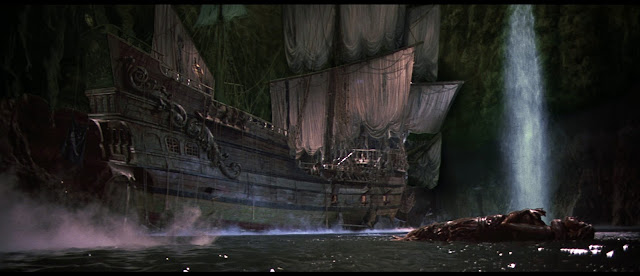 |
| Not many fx shots, and just a couple of mattes as far as I can recall, with this shot of the old pirate ship requiring some painted in set extension to add in more sails, cave walls and such. |
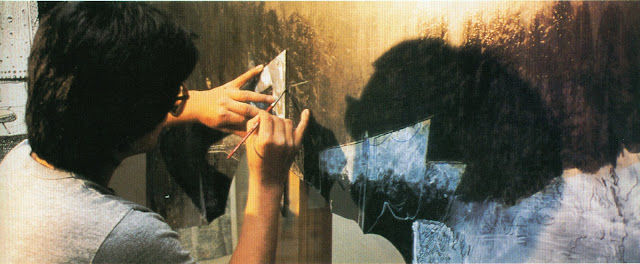 |
| Again, Frank Ordaz has painting duties, and here we can appreciate the invisible fix up work that a good matte artist can do. Also, the Warner Bros. soundstage lighting and gantry work was in frame so this served a dual purpose. |
 |
| Christopher Evans discusses his preliminary sketched in outline for a proposed matte shot with the vfx director, though the final shot, shown below, I read used miniatures(?) |
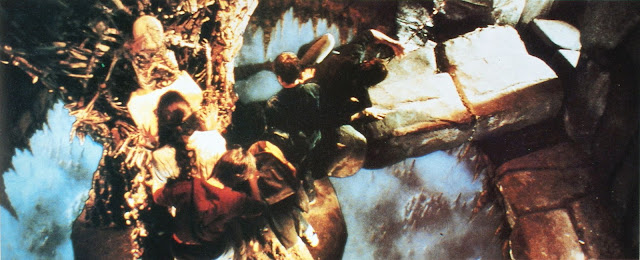 |
| The shot when completed. Though the view seems to be identical to that which Evans had roughed in, I think it was ultimately done with model work(?) |
 |
| I'm pretty sure this well is mostly painted. |
 |
| Long shot of sailing ship at sea was either matte art (most likely) or miniature doubled in. |
 |
| A shot that's not very effective, and has a distinct 'pasted on' quality about it. Not ILM's finest hour. |
---------------------------------------------------------------------------------------------------------------------------
***This post, and all 174 previous blog posts known as 'Matte Shot', were originally created by Peter Cook for nzpetesmatteshot, with all content, layout and text originally published at http://nzpetesmatteshot.blogspot.com/
TO BE CONTINUED....
I'll be back soon with great matte shots from shows like THE GOLDEN CHILD, HOOK, STAR TREK IV, EXPLORERS, ENEMY MINE, THE DARK CRYSTAL, LABYRINTH and even that god-awful HOWARD THE DUCK (o.m.g, what on earth were they thinking!)
---------------------------------------------------------------------------------------------------------------------
***Final word: We here at Matte Shot wish to take this opportunity to extend our kind thoughts and utmost support to the people and legitimate government of the democratic nation of Ukraine.
All the best.
Pete





















































































































































































































































































































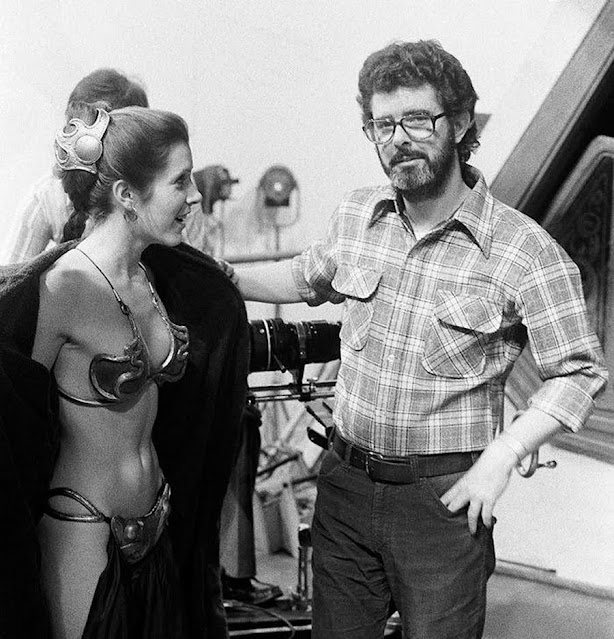



















Brilliant as always! Go Ukraine!!
ReplyDeleteHi Marshall,
DeleteYep.. I knew you'd like this one.
GO UKRAINE absolutely!
Pete
👏 Bravo! Great article! Takes me back to my childhood days. Thank you, Pete.
ReplyDeleteThanks Tommy... I'm always so thrilled to have feedback just like yours. Makes it all worthwhile.
DeletePete
Well deserved, my friend, well deserved. Where's PART 2?
DeleteHi Pete and thank you for another wonderful entry. I have a couple of corrections to your Empire Strikes back section. The image of Cloud City includes a structure on the left which was an addition for the special editions. That structure wasn't there in the original film. You also include a painting of the Death Star hanger bay entrances that should have been included on the Return Of The Jedi section since there was no Death Star in Empire.
ReplyDeleteSadly, and this is purely a matter of personal opinion, I always felt McQuarrie's Cloud City paintings were too obvious. You allude to this in your commentary but I have to agree that they often felt too slick and smooth. His paintings used during the fight between Luke and Darth Vader are very effective however.
Thanks again for the amazing work you do on these blog entries. Amazing work and very much appreciated!
Pierre
Hi Pierre
DeleteThanks for the clarifications. It's very hard to find 'original' un-tampered with fx shots from those, since Lucas re-jigged so much.
I knew a couple of shots would likely slip through, and a SW expert (like your good self) would notice. ;)
Pete
I have a 4k "untouched" original, and I can a attest that Ralphs paintings were spotless. the special editions and later incarnations of Lucas meddling with a cultural masterpiece has made a few shots worse IMO. Wonderful article Pete, I was in Auckland for the LOTR shoot and I did mean to drop you a line but with Covid restrictions and our 90 hour weeks I didn't manage to find that time. However, I will make it one day. till then well done, and I look forward to the next instalment. Simon
DeleteA very welcome return, Pete! I've been refreshing this page for a long while, hoping all was well. Turns out, it's merely summer!
ReplyDeleteThanks Chris,
DeleteHard to get 'into it' in any serious way while the sky is blue and sun is beating down. Definitely gotta be in the mood, as I'm never sure how worthwhile these things will be.
Pete
absolute 100% massively awesome update,as usual..
ReplyDeletekind regards,and greetings from Amsterdam
William
Thank you William. You are always so generous with your comments.
DeleteAmsterdam: great city when I went there many years ago!
Pete
Pete,
ReplyDeleteGreat post! Even though you are wrong about Empire Strikes Back and E.T.!
I had forgotten how many amazing mattes are in Return of the Jedi- it has to be one of the all time best showcases for the art.
Looking foward to part 2. and 3!
- mike
Hello Pete I love your blog. Best blog about optical effects ever. I was wondering if you could do research on fx animation. Gabriel
ReplyDeleteHi Gabriel
DeleteGlad you liked it!
I did do a massive 2-parter on 'optical effects', which includes quite a lot of fx animation back in 2015:
http://nzpetesmatteshot.blogspot.com/2015/10/optical-effects-magical-moments.html
and
http://nzpetesmatteshot.blogspot.com/2015/12/more-magical-moments-from-optical.html
Pete
Hi Pete, Fantastic site about a fascinating subject! Thank you for all the work that must go into each of your entries! I remember first being introduced to matte paintings from the Art of Empire Strikes Back book which I found in a bookshop shortly after the film came out. The book had been thumbed by so many people that it was not in the best condition but I just had to buy it, being the only copy in the shop! More recently, it was seeing an entry on Facebook on Matthew Yuricich's painting for North by Northwest that eventually led me to your blog. Great to see all the names I already knew: McQuarrie, Yuricich, Pangrazio, Ellenshaw and I look forward to exploring the other entries!!! Love the humourous captions on some of the photos too! Melvin.
ReplyDeleteHi Melvin
DeleteYou are the first (and ONLY) Melvin I've ever come across!
Thanks for the kind comment and obvious enthusiasm for this 'lost art'. Yep, a million times more fascinating than the 'other' kind - the computerised variety that is.
Glad you appreciated a few jokey captions too! My mind tends to wander off target when doing these juggernaut scaled bloggings. ;)
Pete
Hi Pete,
DeleteNice to hear from you. Yes, definitely appreciate the humour sprinkled throughout.
Quick question (as I'm still delving into the entries); have you ever done an entry on the technical aspects of how the matte painting eventually finds its way onto the screen, from painting to cinema-photographing it, lighting it, positioning each element, etc.? (I'm guessing those things may also be found somewhere elsewhere on the web but I haven't looked yet). I think we understand the concept of matte paintings but the nitty gritty details are something I've yet to fully understand.
By the way, I'm also curious about the glass that is used for some matte paintings. I work in construction and we commonly use "clear" glass which most of the time has a natural greenish/blue-ish tint. To get really really clear glass, more expensive low-iron glass can be used which has more or less no green tint at all. Just wondering if that's something that is considered, do you know?
Best regards!
Hi Melvin
DeleteWell, that's probably all too much to try to answer here, though much of what you are curious about is to be found amongst my numerous blogs. Just where exactly, i couldn't say off the top of my head (no help to you, I know!) - but it's pretty much covered in 'back issues' of my blog.
What I can say is that every practitioner had his own version of methodology - with some better than others - and techniques advanced over the decades.
Some studios were absolute top rung when it came to this stuff (such as MGM) and certain storied celeb matte fx artists such as Al Whitlock and Peter Ellenshaw were pretty much the creme of the crop when it came to instinctively understanding the medium and the potential therein.
Wade through the blogs and you'll find MUCH to savour, of that I'm certain.
Pete
Thanks for your reply Pete. Dig deeper in to your blog I certainly will! Melvin.
DeleteJust want to reiterate, thank you for the incredible megapost here! Long time reader, always appreciative of the deep dives you do. Your blog is an invaluable resource for classic film FX.
ReplyDeleteActually, E.T. was one of the best movies ever made, and by FAR THE BEST film of the '80s. Hands down. Blade Runner was crap. It was a borefest, with a load of Neon Lights. An Orwellian 'influenced' story, which brought nothing new to the table and desereved to flop like it did. E.T. on the other hand deserved to win 100%. Oh and Poltergeist was a crap too - An Amityville Horror rip-off, done in the style of Star Wars. Have no respect for this site anymore and not coming back ever again, after reading this.
ReplyDeleteWOW! First time an actual 100% 'extra-terrestrial' has managed to leave a comment here! Obviously never went 'home' after all?
DeleteP